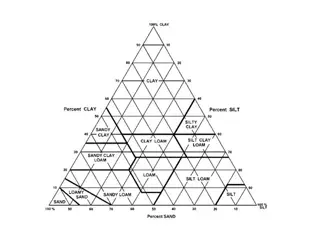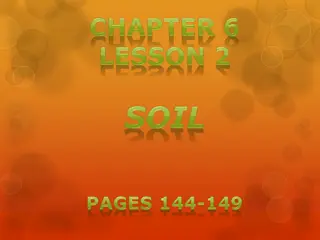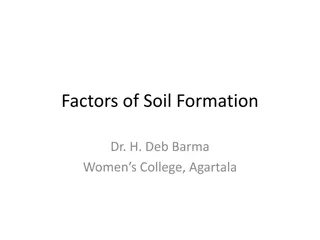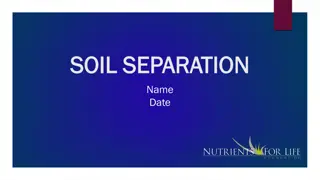Understanding Soil: Formation, Composition, and Impact on Plant Growth
Soil is more than just dirt; it plays a vital role in supporting plant growth. Formed through the weathering of rocks and organic activity, soil consists of rock fragments, clay, and organic material. The process of soil formation begins with the erosion of bedrock, leading to the development of different soil horizons. Factors like porosity and permeability influence the ability of soil to support plant life. Humus, a rich source of nutrients, contributes to soil fertility. Exploring the composition and factors affecting soil helps in understanding its significance in sustaining life on Earth.
Download Presentation

Please find below an Image/Link to download the presentation.
The content on the website is provided AS IS for your information and personal use only. It may not be sold, licensed, or shared on other websites without obtaining consent from the author. Download presentation by click this link. If you encounter any issues during the download, it is possible that the publisher has removed the file from their server.
E N D
Presentation Transcript
WHAT IS SOIL? IT IS NOT JUST, DIRT Soil Defined: formed from the weathering of rocks and organic activity and is composed of loose rock fragments and clay derived from weathered rock mixed with organic material. Soil is primarily made up of, broken down rock (minerals) and organic materials (just like igneous rock, soil is made from the nutrients that are present inside of living organisms)
HOW SOIL FORMS The life cycle of soil begins whenever bed rock in the Earths surface begins to erode over time. Bedrock: Very solid layer of rock beneath the soil. As bedrock begins to erode, the small eroded particles in the bed rock will get deposited onto the surface of the earth, where they begin to form soil.
AS THE BEDROCK BEGINS TO ERODE, THIS IS WHAT WE SEE HAPPENING OVER TIME 1. SOLID ROCK EXPOSED AT EARTH.. 2. BEGINS TO ERODE INTO TINIER, MINERAL PARTICLES,. 3. A LAYER OF SOIL FORMS AT THE SURFACE, THIS LAYER IS A MIXTURE OF VERY TINY SEDIMENT PARTICLES AS WELL AS ORGANIC ORGANISIMS THAT MAKE THE SOIL HEALTHY FOR PLANT GROWTH
WHAT SOIL IS MADE OF HUMUS- Decayed organic matter in soil.. Humus forms as plant and animal remains decay. Humus is very rich in sulfur, phosporus, and potassium. (necessary for plant growth.
SOIL HORIZON- MATURE SOIL THAT IS BROKEN UP INTO THREE SECTIONS A-B-C A-HORIZON: USUALLY DARK IN COLORDUE TO A LOT OF ORGANIC MATERIAL BEING PRESENT IN THE SOIL. WHERE PLANT GROWTH OCCURS B-HORIZON- KNOW AS SUBSOIL MADE OF TIGHTLY COMPACTED CLAY- CLAY IS LIGHT AND IS DEPOSITED FIRST ON THE SURFACE C- HORIZON- DEEPEST LAYER, COMPOSED OF BROKEN BED ROCK
FACTORS AFFECTING PLANT GROWTH POROSITY AND PERMEABILITY POROSITY :is a measure of how much soil is open space. This space can be between grains or within cracks or cavities of the soil .
PERMEABILITY Permeability is a measure of the ability of a rock or sediment to transmit water or other liquids. Water does not pass through impermeable materials. A substantial amount of water is stored in permeable soil and rock underground.
A COMMON TOPOGRAPHIC FEATURE EFFECT BY POROSITY AND PERMEABILITYIS KARST TOPOGRAPHY What is Karst topography? topography developed in areas underlain by carbonate rocks, including limestone and dolomite. Karst topography includes features like caves and sinkholes and forms when limestone is slowly dissolved away by slightly acidic groundwater.
KARST TOPOGRAPHY Karst topography occurs whenever groundwater begins to dissolve away the limestone bed rock below the Earths surface The groundwater is in a layer of moist soil that travels through that layer of soil and begins to dissolve the limestone in the Earth. Would this mean that the soil and limestone in these areas are highly permeable or not very permeable?
WHERE KARST TOPOGRAPHY EXISTS IN VIRGINIA























